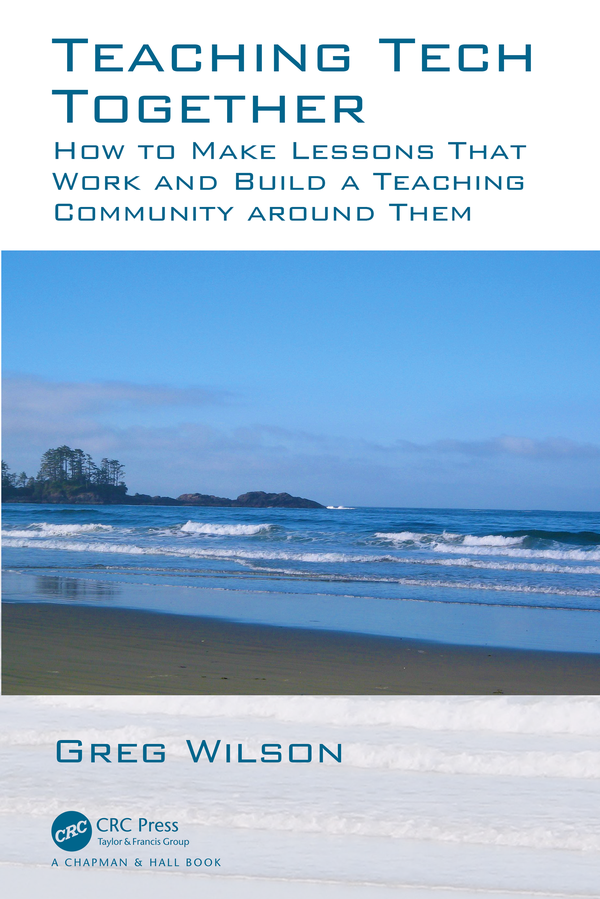Teaching Tech Together
When I left the University of Toronto in 2010, I needed some way to pay the bills while I figured out what I was going to do next. I had enjoyed teaching programming to scientists ever since the first workshop that Brent Gorda and I taught at Los Alamos in 1998, and if people were willing to fund me to do it again, it seemed like as good an idea as any.
Wind forward a year and I had learned two things:
- There was a lot of demand for this kind of training that traditional university programs weren’t satisfying.
- I knew a lot less than I thought I did about teaching and learning.
You have probably experienced both of these yourself. I was lucky during my three years as a professor to meet a few members of the computing education research community, and through them, to discover that we know a lot more about how people learn than most of us realize. Books like How Learning Works, Small Teaching, and Teaching What You Don’t Know, and the work of Sally Fincher and Mark Guzdial, taught me that adopting a few evidence-based practices would produce more effective lessons with less effort. Just as importantly, they helped me overcome my impostor syndrome when I started training other people to deliver Software Carpentry workshops.
Wind forward again to the start of 2017. I took a position as a trainer with a Toronto-based software company and started to reflect on what I had learned from the Carpentries that could transfer to other organizations. Cognitive load? Check. Live coding? Double check. How to use the Carpentries’ workshop template? Probably not: most teaching groups aren’t as distributed as the Carpentries or run fewer but longer events.
As I was sorting and organizing, I realized that a lot of what I had been telling people one-on-one wasn’t in the Carpentries’ instructor training. How do you persuade people to volunteer? How do you make volunteering worthwhile? How do you ask for funding and build ties with other groups? I eventually realized that I had gone from teaching people to program, through teaching them to teach to teaching them to organize.
I made slow progress on writing all of this down until the summer of 2018, when I unexpectedly found myself with time on my hands. A six-week burst of writing produced something that a publisher would take seriously; I was very pleased when Taylor & Francis agreed to take it on, and even more pleased that they agreed to keep the online version up and to donate the royalties to the Carpentries.
The finished book has 15 chapters:
- Introduction
- Mental Models and Formative Assessment
- Expertise and Memory
- Cognitive Architecture
- Individual Learning
- A Lesson Design Process
- Pedagogical Content Knowledge
- Teaching as a Performance Art
- In the Classroom
- Motivation and Demotivation
- Teaching Online
- Exercise Types
- Building a Community of Practice
- Outreach
- Why I Teach
Its appendices include an annotated bibliography, a glossary, a sample code of conduct, and a few other odds and ends. Much of the material in the early chapters come from the Carpentries instructor training; 88 people who have contributed directly or indirectly to https://carpentries.github.io/instructor-training/ are thanked in the acknowledgments, and I’m sure more deserve to be. The later chapters go beyond the Carpentries’ training, and I hope they will eventually serve as the basis for a workshop on how to build inclusive communities of practice.
I learned a lot doing the research for this book. I learned even more from the people I encountered along the way, from early collaborators like Jorge Aranda, Azalee Bostroem, Matt Davis, and Damien Irving to educators and organizers like Valerie Aurora, Michael Jacoby Brown, Neil Brown, Warren Code, Tressie McMillan Cottom, and Audrey Watters. I hope you enjoy it, and I hope we can teach together some day.

Start where you are.
Use what you have.
Help who you can.
@book{t3,
author = {Greg Wilson},
title = {Teaching Tech Together},
publisher = {Taylor \& Francis},
year = {2019},
isbn = {978-0-367-35328-5},
link = {http://teachtogether.tech}
}